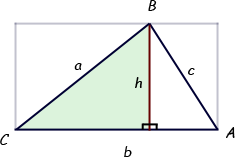| |||
| Math Central | Quandaries & Queries |
|
Question from Eileen, a student: Use a formal Statement/Reason Proof to prove the following. Include a diagram, labeled appropriately. Given: Acute triangle ABC, with a, b, c, being the respective opposite sides to angle A, angle B, angle C, and altitude, h, drawn from angle B to b. Prove: The area of triangle ABC=1/2abSin C How would I do this?? |
Hi Eileen.
There are many ways to do it. I would start by drawing the triangle, inside the rectangle (remember that the altitude h is perpendicular to the base b).
First, you can say that the area of the rectangle is hb. Then you can reason that the triangle's area is ½hb since it neatly divides the rectangle into two pairs of congruent triangles.
Now look at the right triangle I've shaded. Can you find an expression for h in terms of a and C? If so, replace h in the ½hb calculation and you will have proved the solution.
Cheers,
Stephen La Rocque.
 |
||
Math Central is supported by the University of Regina and The Pacific Institute for the Mathematical Sciences.
